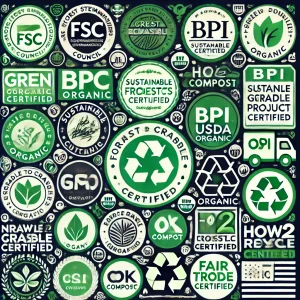
Who doesn’t want a greener, more sustainable lifestyle? As the demand for eco-conscious living grows, one small but mighty way to make a positive impact is by snacking sustainably! Being mindful of our choices in packaging and ingredients, can ensure that we get to enjoy our favorite treats while being kind to the planet. Here’s how to snack more sustainably without sacrificing taste or convenience.
1. Choose Snacks with Eco-Friendly Packaging
Packaging waste is one of the biggest contributors to environmental pollution. From single-use plastic wrappers to non-recyclable containers, the packaging of many snacks can end up in landfills. Fortunately, more and more companies are adopting sustainable packaging solutions. Look for snacks that use biodegradable materials, compostable packaging – with compostable certifications like BNQ & BPI (drop the material into compost bins, nothing goes to the landfills) and recyclable materials (helps reduce the demand for virgin resources).
When shopping, keep an eye out for certifications like FSC (Forest Stewardship Council) or SFI (Sustainable Forestry Initiative) and other such labels indicating that the product is made with sustainable materials.
More on label codes:
You might have wondered about some of the labels and logos on packaging, read about them here:
I. Compostable Certification:
a. BNQ (Bureau de normalisation du Québec) is a Canadian standard certifying that packaging materials are compostable in municipal and industrial composting facilities.
b. BPI (Biodegradable Products Institute): Recognized in North America, BPI certifies that packaging is compostable according to ASTM standards.
II. CFIA (Canadian Food Inspection Agency) Compliance: While not a certification logo, all food packaging in Canada must comply with CFIA regulations to ensure that the materials used are safe and suitable for food contact.
III. FSC (Forest Stewardship Council) certification is used in Canada for food packaging, but it’s primarily related to ensuring that the paper and cardboard used in the packaging come from responsibly managed forests.
IV. EcoLogo (UL Environment): A Canadian certification that covers a wide range of environmentally friendly products, including food packaging, EcoLogo certifies products based on a comprehensive set of criteria, from resource conservation to recyclability.
V. How2Recycle: This is a standardized labeling system in North America that communicates clear recycling instructions to consumers. Widely seen on food products, it guides proper disposal to improve recycling rates.
VI. Recyclable Symbols: Packaging with the Mobius Loop or other recycling symbols indicates that it can be recycled, depending on local recycling programs.
VII. Plastic Codes (Resin Identification Codes): plastic food packaging is often marked with these codes to show what type of plastic it is (e.g., PET, HDPE). This helps consumers and recycling facilities to sort and process the materials correctly.
VIII. Green Seal: It is a non-profit organization that certifies products and services that meet rigorous environmental and health standards. Packaging that carries the Green Seal label has been evaluated for reduced toxicity, recycled content, and minimal environmental impact.
IX. USDA Organic: This label certifies that the food and its packaging materials meet strict organic standards set by the U.S. Department of Agriculture. It also ensures that packaging materials avoid harmful chemicals and are environmentally friendly.
X. Non-GMO Project Verified: This certification focuses primarily on food ingredients, but when used in packaging, it indicates that the product avoids genetically modified organisms (GMOs) and promotes responsible agricultural and packaging practices.
XI. Cradle to Cradle Certified™: This certification assesses products, including food packaging, across five categories: material health, material reuse, renewable energy, water stewardship, and social fairness. When you see this label on the packaging it means that the materials are safe, circular (reusable or biodegradable), and sustainably produced.
XII. OK Compost: This guarantees packaging materials will fully biodegrade in an industrial composting facility. Commonly seen on biodegradable food packaging materials, it ensures that the packaging can break down without harming the environment.
XIII. Ocean Bound Plastic Certification (Zero Plastic Oceans): This certification focuses on preventing plastic waste from ending up in oceans by collecting and reusing plastic materials near coastal areas. Food packaging that contains recycled ocean-bound plastic showcases its role in preventing marine pollution.
2. Opt for Snacks with Natural and Ethical Ingredients
We know you know that the ingredients in your snacks matter just as much as the packaging. By selecting snacks made from sustainably farmed, organic, and non-GMO ingredients, you can support ethical agricultural practices that are better for the planet.
Look for Fair Trade certified products that ensure that farmers are paid fair wages and that environmental sustainability is prioritized. Another way to go green would be to favor locally sourced ingredients so they leave a smaller carbon footprint. Also keep in mind that plant-based options typically mean lower greenhouse gas emissions, and less land, water, and energy usage, so they have a smaller environmental impact compared to animal-based products.
3. Support Brands with Sustainable Initiatives
Finally, support companies that take sustainability seriously. Some brands are committed to reducing their carbon footprints by minimizing waste, using renewable energy, or giving back to environmental causes. By voting with your wallet, you encourage more companies to adopt eco-friendly practices.
The Future of Snacking: Active Intelligent Packaging
There is a lot of research on Food waste and Byproducts (FWBP) and this is paving the way for a brave new frontier in food packaging! Say goodbye to stale snacks and hello to the future of freshness! Active intelligent packaging is revolutionizing the way by using innovative materials that do more than just wrap your favorite treats. Imagine packaging that keeps produce fresh but also responds to changes in the environment, like moisture or oxygen levels, to protect your food. Some even have built-in sensors to let you know when your snack is at its peak freshness. Edible films derived from polysaccharides, proteins or lipids offer a glimpse of a future where packaging waste is drastically reduced.
Snacking sustainably will not seem full of complicated choices now! With eco-friendly packaging and thoughtfully sourced ingredients, you can enjoy your treats while keeping the planet healthy.

Post Comments